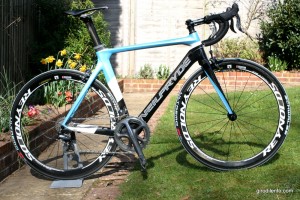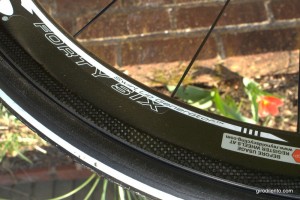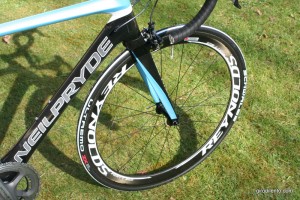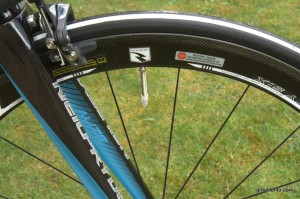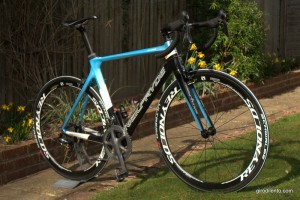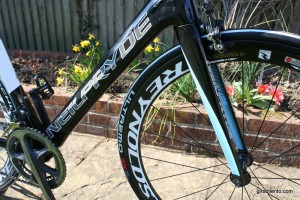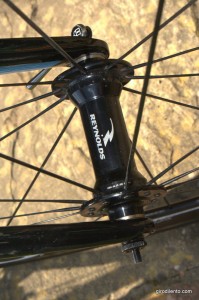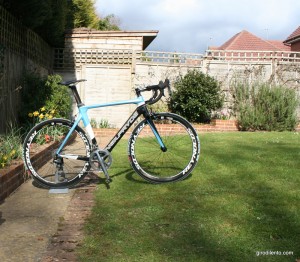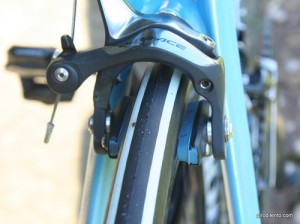Something that’s really stood out to me in watching the beginning of this season’s pro-cycling coverage is how many team bikes are now running 40mm+ deep section aero wheels on every stage – even those with a lot of climbing. Seriously, take a look at any pro road race going on and check it out if you haven’t already noticed it.
Now as someone who owns an aero road bike – a logical next step is to put some appropriately aero wheels on it – but according to wiser people than I within the industry, aero wheels can make a noticeable difference to the speed and effort required on any bike.
With this in mind I asked Reynolds if they’d be open to loaning me a set of deep section wheels and I picked up this set of Forty Six’s late last week to spend time riding.
Reynolds effectively have three ranges of carbon aero wheels Road Racing, which includes the state of the art RZRs at the top of the tree (under 1kg for a pair of 46mm deep carbon tubulars!), then the Thirty Two, Forty Six, Sixty Six, a more affordable range called Competitive Road including the Strike, Assault, Attack and (the non carbon) Solitude as well as a range of Triathlon/TT wheels featuring up to 92mm depth
Priced at just under £2k a pair in the UK these are what I’d call an upper mid range priced wheel set and they’re priced to compete with aero wheels from Zipp, ENVE, HED. (for me the high end is £2.5k up).
Carbon wheels at this end of the market even a handful of years ago were mainly tubular and the lightest wheelsets still are. For the Forty Six, a tubular set weighs in at just over 1200gms a pair whereas the clinchers like I’m riding are just over 1400gms a pair. 1400gms still makes them lighter than any of the alloy clincher wheels I’ve been riding on my Alize. Reynolds tell me that 70% of the wheels they sell are clinchers and the Reynolds brochure tells me that the AG2R pro team rode clincher Reynolds in last years Tour de France. Most of us weekend warriors also favour clinchers because we’re used to changing clincher flats but changing a tubular flat is far more intimidating (perhaps just because we’ve not done it).
Because of all of this, wheels manufacturers including Reynolds have been investing significant resources in building clinchers wheelsets that are engineerd to be strong enough and durable enough for daily use over a varieity of road surfaces and this is where the extra 200gms of weight largely comes from.
I’ll cover the technical aspects of the wheels in deeper detail in my next post on the wheels. For this post I want to touch on two more aspects, the looks and the first ride report.
I spoke to a retailer this week and asked him if they were selling many set of deep section carbon wheelsets and was told volume is going up quickly. His answer to why are people buying them was not exactly what I was expecting – that customers are buying them mostly because they look great on most bikes.
This is definitely true. I think the Reynolds look great on my own bike and they look more “right” on an aero bike for sure.
For me, the most important reason to try these wheels is to see if I can detect a discernible aero gain from the engineering put into the design and construction.
My first test of this was on Tuesday, when I went out on a rolling loop of roads I know extremely well. From the first 500 metres, these wheels felt fast and my Garmin display was echoing what I was feeling. It seemed to be easier to get up to a good speed and hold it. Normally when I ride this loop at about 10kms in I am looking to averaging near to 30kph – so I’m looking for the 10km in 20minutes and I’m checking this mental arithmetic as I ride. With these wheels I was initially confused as my mental calculations weren’t working normally …. because I was averaging over 30kph rather than under. In fact I managed to keep the average speed above 30kph until 17km through the ride including over 200m of climbing – something I’ve not managed before. My speed only dropped below 30kph after my riding glasses fell off at about 55kmh on a descent, so I had to stop, turn around, ride back up the hill looking for them, get them back on, turn around and continue. I also managed two personal best times on the ride – one a short steep climb and the other a longer draggy uphill section that my previous best was set when I was much fitter.
I’m still rebuilding my fitness from a chest infection that wiped February out – so believe me I’m not fit enough to be riding that quickly. My fitness is getting there but I still shouldn’t be riding that quickly.
This was a very promising first ride. Now certainly there may be a placebo effect but I’m not sure that’s what happening. I genuinely think these wheels feel very quick from the first ride.
A couple of other things I noticed include – they hold speed incredibly when you’re up to speed (including coasting) and I imagine if you’re riding in a group you’ll be using less energy to hold the pace and this could make a real difference in a race. They climb really well at the first impression. Last year I wrote about a set of Mavic Cosmic Carbones that I had (http://girodilento.com/2011-mavic-cosmic-carbone-sl-first-thoughts), which I loved but they were a poor climber as they were heavy. Not so the Forty Sixs in fact they were great to climb on and I found myself able to accelerate on relatively steep gradients.
The only minor down side is that on the first ride, they weren’t as comfortable as I was expecting. They weren’t harsh or uncomfortable by any means but the ride was just a bit less smooth than I expected.
The braking using Reynolds specially supplied pads (in a nice blue that matches my bike) was fine on the first ride – not as good as my alloy clinchers but good nonetheless.
Overall my first impression is extremely positive – light, very fast, look great and an absolutely perfect example of credit card speed, which is an intoxicating thought in itself. I’m really looking forward to spending more time on these wheels, including longer, more challenging climbing, descents and flat road riding. The Forty Six seems like it could be a perfect depth for all round riding; deep enough for genuine aero benefit, light enough to climb well and will look great on a lot of bikes.
I’ll write again once I’ve spent more time on them but if you’re looking at aero wheels – these should be on your short list.
Here is some other information to consider including a couple of excellent professional reviews:
http://road.cc/content/review/52375-reynolds-forty-six-wheelset
http://roadcyclinguk.com/news/gear-news/reynolds-forty-six-clincher-wheelset-review.html
http://www.reynoldscycling.com/index.php?p_resource=items_wheels_item&p_itm_pk=595
Thanks for reading

